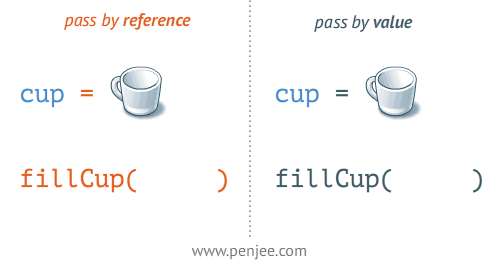理解 Golang 中的值传递与引用传递
本文是Golang Pass by value vs Pass by reference的中文翻译版本,内容有删减

值传递和引用传递是使用指针类型时需要尤其注意的点(特别是在Java, C#, C/C++和Go等语言中)
当使创建方法/函数包含参数时,该参数可以选择使用普通数据类型或指针来进行传递。这将使传递给方法的参数有所不同:
- 按值传递 会将变量的值传递到方法中,或者可以说是将原始变量将值“复制”到另一个内存位置并将新创建的值传递到方法中。因此,在方法中变量发生的任何改变都不会影响原始变量值。
- 按引用传递 将传递变量的内存位置而不是值。换句话说,它将变量的“容器”传递给方法,因此,方法中变量的任何改变都会影响原始变量。
简而言之,按值传递将复制值,按引用传递将传递内存位置。
下图是清晰得解释了按值传递和按引用传递的区别
![][img-1]source: www.penjee.com
在Go语言中,我们可以处理指针,因此我们必须了解按值传递和按引用传递在 Go 中的工作原理,本文将它分为 3 个部分:“基本”、“引用”、“函数”。
源代码地址: https://github.com/david-yappeter/go-passbyvalue-passbyreference
基本数据类型(Basic Data Type)
package main
import "fmt"
func main() {
a, b := 0, 0
// Initialize Value
fmt.Printf("## INIT\n")
fmt.Printf("Memory Location a: %p, b: %p\n", &a, &b)
fmt.Printf("Value a: %d, b: %d\n", a, b) // 0 0
// Passing By Value a(int)
Add(a) // Golang will copy value of 'a' and insert it into argument
// Passing By Reference b(int), &b(*int) => with '&' we can get the memory location of 'b'
AddPtr(&b) // Pass Memory Location of 'b' into argument
fmt.Printf("\n## FINAL\n")
fmt.Printf("Memory Location a: %p, b: %p\n", &a, &b)
fmt.Printf("Value a: %d, b: %d\n", a, b) // 0 1
}
// Pass By Value
func Add(x int) {
fmt.Printf("\n## 'Add' Function\n")
fmt.Printf("Before Add, Memory Location: %p, Value: %d\n", &x, x)
x++
fmt.Printf("After Add, Memory Location: %p, Value: %d\n", &x, x)
}
// Pass By Reference
func AddPtr(x *int) {
fmt.Printf("\n## 'AddPtr' Function\n")
fmt.Printf("Before AddPtr, Memory Location: %p, Value: %d\n", x, *x)
*x++ // We add * in front of the variable because it is a pointer, * will call value of a pointer
fmt.Printf("After AddPtr, Memory Location: %p, Value: %d\n", x, *x)
}
Output:
## INIT
Memory Location a: 0xc0000120a8, b: 0xc0000120c0
Value a: 0, b: 0
## 'Add' Function
Before Add, Memory Location: 0xc0000120f0, Value: 0
After Add, Memory Location: 0xc0000120f0, Value: 1
## 'AddPtr' Function
Before AddPtr, Memory Location: 0xc0000120c0, Value: 0
After AddPtr, Memory Location: 0xc0000120c0, Value: 1
## FINAL
Memory Location a: 0xc0000120a8, b: 0xc0000120c0
Value a: 0, b: 1
在第一个例子中,我们将研究基本数据类型。以下有 2 个函数:
Add(x int)的输入是一个integerAddPtr(x *int)的输入是一个integer指针
a和b这两个变量在内存中的位置无法预测,但我们可以通过打印它们的内存位置来追踪它们。
在Add函数中,a在main()函数中的位置与在Add不通,是因为 Go 复制 a的值并在内存的其他位置重新初始化一个地址,所以如果我们通过x++是不能更改main()函数中的a的值。最终因为是按值传递a的值还是0
在AddPtr函数中,b在main()函数中的内存位置与在AddPtr是一致的,我们在AddPtr函数对x 的操作最终会影响 b 的值。因此当我们尝试通过*x++来更改x值的时候,最终因为当前是按引用传递b的值会变成1。
其他的基本数据类型比如int, int8, int16, int32, int64, uint, uint8, uint16, uint32, uint64, uintptr, float32, float64, string, bool, byte, rune, Array, Structs都符合上述规律
引用数据类型(Referenced Data Type)
package main
import (
"fmt"
)
func main() {
// Slices
fmt.Println("======================")
fmt.Println("SLICES")
fmt.Println("======================")
var arrInt []int = []int{1, 2, 3, 4, 5}
var sliceInt = arrInt[3:]
fmt.Printf("Init\n")
fmt.Printf("ArrInt: %+v, SliceInt: %+v\n\n", arrInt, sliceInt)
sliceInt[0] = 10
fmt.Printf("After\n")
fmt.Printf("ArrInt: %+v, SliceInt: %+v\n", arrInt, sliceInt)
// MAP
fmt.Println("======================")
fmt.Println("MAP")
fmt.Println("======================")
var emptyMap = make(map[string]interface{})
fmt.Println("Init")
fmt.Printf("emptyMap : %+v\n", emptyMap)
MapFunc(emptyMap)
fmt.Println("After")
fmt.Printf("emptyMap : %+v\n", emptyMap)
}
func MapFunc(val map[string]interface{}) {
val["this is a new value"] = 100
}
Output:
======================
SLICES
======================
Init
ArrInt: [1 2 3 4 5], SliceInt: [4 5]
After
ArrInt: [1 2 3 10 5], SliceInt: [10 5]
======================
MAP
======================
Init
emptyMap : map[]
After
emptyMap : map[this is a new value:100]
在第二个例子中,数组中的Slices因为和数组共享内存位置,因此如果我们更改Slices的值,它将影响数组值,并且map数据类型默认为按引用传递,因此函数内部的任何更改都将更改原始值。如果我们想为map做一个传递值,我们可以使用copy,它将创建map的新变量,这样函数中值的改变不会影响原始值。chan或通道也是引用的数据类型。
函数(Function)
package main
import "fmt"
type StructVal struct {
IntVal int
}
func (s StructVal) Add() {
fmt.Printf("====================\n")
fmt.Printf("Func Add\n")
fmt.Printf("====================\n")
fmt.Printf("Memory Location %p\n", &s)
fmt.Printf("Value Before: %+v\n", s)
s.IntVal++
fmt.Printf("Value After: %+v\n\n", s)
}
func (s *StructVal) AddPtr() {
fmt.Printf("====================\n")
fmt.Printf("Func AddPtr\n")
fmt.Printf("====================\n")
fmt.Printf("Memory Location %p\n", s)
fmt.Printf("Value Before: %+v\n", s)
s.IntVal++
fmt.Printf("Value After: %+v\n\n", s)
}
func main() {
init := StructVal{
IntVal: 0,
}
fmt.Printf("================\n")
fmt.Printf("MAIN\n")
fmt.Printf("================\n")
fmt.Printf("Memory Location: %p\n", &init)
fmt.Printf("Value: %+v\n\n", init)
init.Add()
fmt.Printf("================\n")
fmt.Printf("AFTER Func Add()\n")
fmt.Printf("================\n")
fmt.Printf("Value: %+v\n\n", init)
init.AddPtr()
fmt.Printf("================\n")
fmt.Printf("AFTER Func AddPtr()\n")
fmt.Printf("================\n")
fmt.Printf("Value: %+v\n\n", init)
fmt.Printf("================\n")
fmt.Printf("FINAL\n")
fmt.Printf("================\n")
fmt.Printf("Value: %+v\n", init)
}
Output:
================
MAIN
================
Memory Location: 0xc00001c030
Value: {IntVal:0}
====================
Func Add
====================
Memory Location 0xc00001c040
Value Before: {IntVal:0}
Value After: {IntVal:1}
================
AFTER Func Add()
================
Value: {IntVal:0}
====================
Func AddPtr
====================
Memory Location 0xc00001c030
Value Before: &{IntVal:0}
Value After: &{IntVal:1}
================
AFTER Func AddPtr()
================
Value: {IntVal:1}
================
FINAL
================
Value: {IntVal:1}
在最后一个例子中,我们将处理 Struct Function。不同之处在于Struct本身,而不是Struct内部的变量。当我们创建一个Struct函数时,我们将Struct声明为函数的前缀,例如func (s struct) FuncName()或func (s *struct) FuncName()。不同之处在于,如果我们使用指针类型的函数func (s *struct) FuncName(),它的输入是原始的Struct,因此Struct值发生的任何变化都会对原始Struct产生影响,而没有指针的函数func (s struct) FuncName() ,则将复制Struct并将其传递给函数。 因此,如果Struct的值在函数中发生任何变化,它不会影响原始结构。